Winter 2023 The Future of Discovery at VCU Health Fighting Fentanyl VCU HEALTH’S LEADERSHIP IN ADDICTION RESEARCH lethal dose
BOARD OF TRUSTEES
Wyatt S. Beazley IV
John O. Beckner, R.Ph.
Michael C. Bisceglia
Charles F. Bryan Jr., Ph.D.
Elizabeth Whalley Buono
George W. Burke III, M.D.
Robert C. Canfield
Alex W. Cecil
I. Lee Chapman IV
Richard M. Clary, M.D.
Sheila A. Corcoran
Charles F. Crone
Paul W. Croston
D. Oscarlyn Elder
George P. Emerson Jr.
Peter F. Farrell
Robert L. Findling, M.D.
Jennifer F. Flinchum
Louis N. Formica, D.D.S.
Moses W. Foster Jr.
Stephen J. Gaidos
Sheryl L. Garland
Stephen M. Goddard
Elizabeth Hopkins
Basil Leonard Hurst III
Darius A. Johnson
Susan G. Kornstein, M.D.
Marlon F. Levy, M.D.
J. Keith Middleton
H. Frederick T. Moore
Ghulam D. Qureshi, M.D.
Kee Tilghman Rabb
Michael Rao, Ph.D.
W. Taylor Reveley III
Michele A. Romano, M.D.
Liza Jarvis Scott
Louise Woltz Smith
Ellen E. Spong
Tracy Kemp Stallings
James H. Starkey III
Judith Forehand Starkey
Richard P. Wenzel, M.D., M.Sc.
T. Spencer Williamson
Rachel L. Yost
A Bright Future for Care and Research

Dear Friends,
The new year always brings excitement and hope of new developments in research and care on the MCV Campus. Accordingly, we begin the first issue of 2023 with stories about discovery and innovation at VCU Health.
Our cover story highlights VCU Health’s strength and leadership in addiction research and treatment, an ever-timely topic as the opioid epidemic continues to haunt communities across America. In December, The Washington Post reported that fentanyl is now the leading cause of death for Americans aged 18 to 49. VCU is one of the top-funded universities for addiction research. The cover story describes our work to reverse this devastating trend. Whether exploring ways to reverse the toxic effects of fentanyl or designing a clinic that helps break down barriers to treatment, VCU Health is committed to reducing suffering among those affected by addiction.
Our history of organizational strength is another theme as the Evans-Haynes Burn Center at VCU Health celebrates the 75th anniversary of its establishment as the first civilian burn unit in the country. Today it continues to lead in specialized care for burn victims. In this story, we explore what makes the patient care at EvansHaynes exceptional. This issue also looks at the work being done to revolutionize the pharmaceutical supply chain and to make Central Virginia a strategic hub of domestic pharmaceutical manufacturing through the work of B. Frank Gupton, Ph.D., at VCU’s College of Engineering and Medicines for All Institute.
Innovation is at the heart of cancer care provided by VCU Massey Cancer Center. We have included two features that profile exciting treatment and research at Massey. MRI-guided radiation puts our cancer center among the very few across the world that offer such a treatment. Another team of researchers has seen promising lab results in development of future treatments by engineering viruses that will selectively target and eliminate cancer cells while leaving healthy cells unharmed.
We are energized by every issue of NEXT magazine because it reminds us of the remarkable level of research and national leadership that exist in Richmond. We know the future is bright for VCU Health, and, most importantly, for patients from across Central Virginia and beyond who will benefit from the advances being made
Best wishes,
Margaret Ann Bollmeier PRESIDENT AND CEO
Ellen E. Spong BOARD CHAIR
COVER STORY
12 Fighting Fentanyl
VCU Health’s strong leadership in addiction research includes finding ways to reverse the toxicity of fentanyl and designing clinical practices to overcome barriers to care.
Cover Note
Fentanyl, a synthetic opioid often crushed into powder and mixed into other street drugs like heroin, is 100 times stronger than morphine. An amount as small as the 2 milligrams pictured on the cover is enough to be lethal.
02 Excellent Margins
Radiation therapy guided by MRI scanners places VCU Massey Cancer Center among the few institutions globally that offer an innovative and incredibly precise way to treat patients.
06 Cancer Treatment Goes Viral
Massey Cancer Center and VCU Institute of Molecular Medicine researchers have engineered a virus to target and kill cancer cells, providing an inventive path to treating cancers.
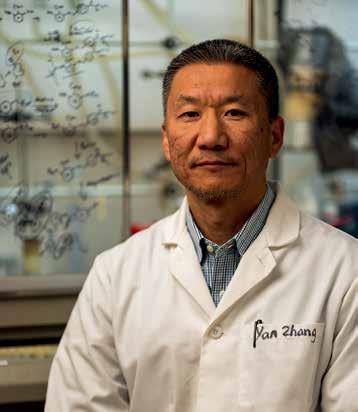
20 Warmth and Compassion
As the country’s oldest civilian burn center, VCU Health’s Evans-Haynes Burn Center helped test and develop the best standards of care.
26 Scaling Up
VCU’s Medicines for All Institute is at the center of a growing regional pharmaceutical ecosystem that will address supply chain and manufacturing challenges around the world.
32 Follow-Ups
Examining two years of COVID-19 smell loss insights and checking in on important oral health research related to cancer.
WINTER 2023
MCV FOUNDATION 1
Excellent Margins
Radiation therapy guided by MR imaging places VCU Massey Cancer Center among the few institutions globally that offer an innovative and incredibly precise way to treat patients.
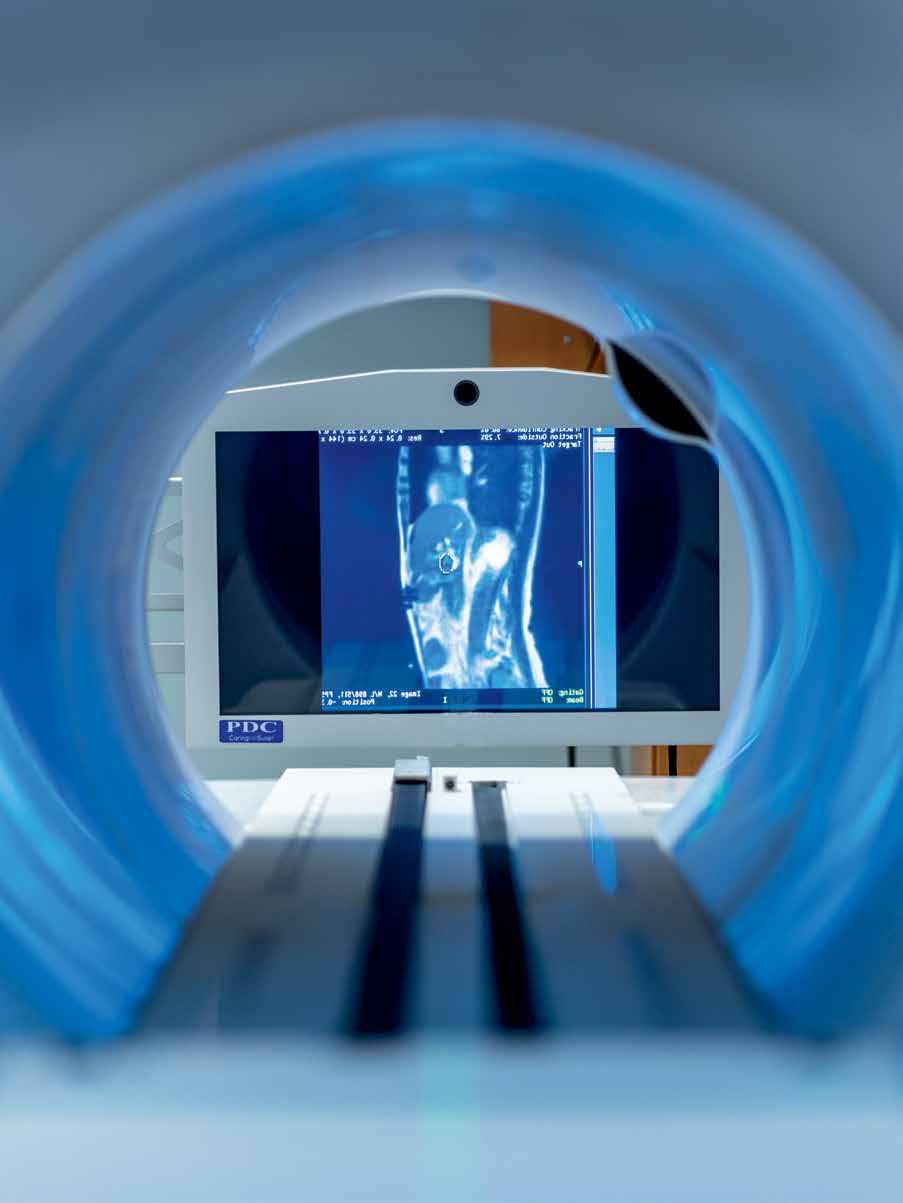 By Holly Prestidge
By Holly Prestidge
It’s a scenario ripe for a Hollywood sci-fi thriller — or every radiation oncologist’s dream: doctors watching high-definition images in real time as radiation beams zero in on cancer somewhere in the body within millimeters of precision.
As this scene plays out, those invisible beams take aim and fire away. Moments later, though, they stop.
The very act of breathing by the patient can cause a tumor to shift within the body — ever so slightly — but enough to warrant stopping so that radiation avoids hitting healthy tissues or organs around the tumor.
A moment later, the patient relaxes. The tumor, back in the sights of those invisible beams, is once again being zapped.
Such technology seems futuristic and revolutionary, and it is, but it’s also a standard of care available now on the MCV Campus. VCU Massey Cancer Center is among 23 programs nationally and 52 worldwide that use the MRI-guided radiation therapy system from ViewRay Inc. It’s a simple premise unlocked only in the last decade thanks to highly sophisticated technology that has the potential to achieve previously unimaginable outcomes for those fighting cancer.
The ViewRay system, called MRIdian, is one of two commercial MRI-Linear Accelerator (MR-Linac) systems available. It combines high definition, MR imaging performed in real time with a linear accelerator that has the potential to target tumors with escalated dosages of X-ray radiation.
The imaging is so precise that virtually all the healthy tissue and organs around the tumor are spared from high radiation doses. Additionally, treatment stops if the tumor moves outside of defined boundaries and can be recalibrated in real time to adjust to each patient’s needs.
“Just 10 years ago, people thought this was impossible to do,” said William Y. Song, Ph.D., director of VCU’s Medical Physics Graduate Program and professor in the Department of Radiation Oncology.
Today’s standard radiation treatments involve imaging and treatments as separate steps. This new MR-Linac technology, as it’s commonly known, removes a significant barrier for simultaneous imaging and treatment. Traditionally, high X-ray energy producing linear
accelerator rooms were no place for strong magnetic fields produced by medical MRI machines.
“Now the integration of the two technologies is a reality, and VCU Health having this machine offers an advantage in the field of cancer treatment,” Dr. Song said.
“VCU Health is the only institution between Pennsylvania and Florida to have this machine clinically operational.”
Medical professionals agree that for many tumor sites there’s no better medical imaging modality than an MRI, Dr. Song said. X-rays, ultrasounds and CT scans, for example, often don’t offer the level of image quality and accuracy needed to target a tumor.
“We’re trying to treat something that is difficult to see with current methods,” said Elisabeth Weiss, M.D., professor in the Department of Radiation Oncology. “The MRI gives you the best chance of seeing the target and then hitting it.”
An MRI “shows us the healthy organs we want to spare from the radiation, in much more detail,” especially in areas like the upper abdomen, the pelvis and the brain, she said.
“It’s precise and accurate and because of that, we can oftentimes spare the healthy tissues better, meaning less toxicity from the treatment and better quality of life,” Dr. Weiss said.
The ability to watch the tumor in real time is a gamechanger in the field of radiation oncology.
“We can see it so well in real time that the treatments can be adapted rapidly based on the patient’s needs and whether the patient’s tumor or healthy organs have shifted positions,” she said. Those shifts could be minimal — a few millimeters or less — “but it might be enough to prompt the creation of a new treatment plan on the fly. It’s very much customized to the individual patient.”
Dr. Song echoed those thoughts, explaining that the ability to stop treatments when the machine detects the tumor has shifted is invaluable.
“Without accuracy in targeting the tumor, it contradicts what we want to achieve,” he said. “That’s why this machine works so well — all of that organ motion, we watch it in real time and adjust the radiation such that you get the accuracy back to millimeters.”
MCV FOUNDATION 3
VCU Massey Cancer Center is one of 23 programs nationally that uses an MRI-guided radiation therapy with high-definition, real-time imaging to precisely target radiation treatments to solid tumors. Photo: Tyler Trumbo, MCV Foundation
Massey began using MR-Linac treatments in February 2022. What doctors and researchers have found is that treatment duration can be cut substantially and safely. Weeks of treatments can be reduced to as few as five treatments, given every other day, because doctors and clinicians can adjust treatments in real time. Each treatment may be longer than standard radiation treatments, but there will be far fewer of them.
MR-Linac is noninvasive. The radio-frequency signals produced during MR imaging are safe and add no additional radiation, unlike X-rays and CT scans that use ionizing radiation to generate images.
The accuracy of hitting the tumor means patients can receive higher dosages of radiation each time — another factor that shortens their treatment time.
“Patients love this machine,” Dr. Weiss said, and not just because duration can be reduced. There’s an interactive component not possible with standard radiation machines.
While lying in the MR-Linac, mirrors inside reflect the MR images, so patients see what doctors see. They can see the tumor inside the predefined boundaries that are colored red and blue. Patients can also see when the tumors move.
It’s almost video game-like, Dr. Song said, in that patients can help doctors target the tumor, sometimes by simply holding their breath and being completely still while the radiation is administered.

Dr. Weiss said MR-Linac’s capabilities currently work best for those with localized tumors in the pancreas, liver and prostate, and soon, the brain. The technology has enormous potential, but it has changed patient throughput.
Standard radiation machines can treat dozens of people daily. MR-Linacs treat roughly five to six patients each day
for longer spans of time. There are few side effects with regard to toxicity from radiation exposure to healthy tissue and organs. Additionally, standard radiation machines require patients to be immobilized during treatment. MR-Linacs require only minimal immobilization.
Dr. Weiss said side effects are categorized on a scale of 1 to 5, with grades 1 and 2 indicating low toxicity. Where cancer treatments using standard radiation machines impact an estimated 5% to 10% of patients causing highgrade toxicity, high-grade side effects have been reduced to nearly zero with MR-Linacs.
“It’s really very effective in avoiding side effects from the treatment,” she said. “It’s the dream of every radiation oncologist to have a machine where you see the tumor and just treat the tumor when it’s in the right position.”
WHAT’S NEXT?
Dr. Song said the MR-Linac opens a world of research and teaching possibilities for VCU and VCU Health.
Several Ph.D. and master’s students as well as postdoctoral research fellows are currently working on projects involving the technology. One is studying the effects of pancreatic cancer treatments on a standard linear accelerator machine versus MR-Linac, the results of which thus far indicate doctors can safely escalate radiation amounts when compared with standard machines.
There is interest in using this technology to study brain tumors, particularly why they reoccur. Yet another student is researching the machine’s mechanics, hoping to establish best practices for maintaining geometric and imaging accuracy.
VCU Massey Cancer Center doctors and clinicians study patient images captured with an MRI-guided radiation therapy system. The system, called MRIdian, uses high-definition imaging to help target tumors with escalated dosages of X-ray radiation.
Photo: Tyler Trumbo, MCV Foundation
“It’s the dream of every radiation oncologist to have a machine where you see the tumor and just treat the tumor when it’s in the right position.”
4 WINTER 2023
Elisabeth Weiss, M.D., professor, Department of Radiation Oncology
The Best Care in Your Backyard
Michael Besche is walking, talking, living proof that modern medical technology works miracles.
A journey that began more than 25 years ago with a renal cancer diagnosis and nephrectomy, followed more than a decade later by a new tumor in his lung, two on his pancreas and one on a remaining adrenal gland, led Besche to VCU Massey Cancer Center, one of 23 programs nationally and 52 worldwide that use the MRI-guided radiation therapy system from ViewRay Inc.
That system, called MRIdian, combines the precision of high definition, MR imaging found in MRI technology with linear accelerators that have the potential to precisely target tumors using escalated dosages of radiation.
By 2022, Besche’s drug regimen was no longer working in the treatment of the tumor on his remaining adrenal gland, as well as one on his pancreas. In researching his options earlier last year, Besche learned that Massey offered the MRI-guided technology. He consulted with Massey doctors over the phone in June and decided to pursue that course of action.
“I thought it was the best technology out there,” Besche said, in part because the MRI technology was advanced enough to reduce the potential danger to his healthy organs.
“I was told that if radiation wasn’t exact, it could perforate the colon — at that point, you’re in danger of dying.”
Ultimately, he had three treatments on his pancreas and three on his adrenal gland at Massey over the course of two weeks in late July and early August. Besche said he was
prepared for potential side effects, including nausea. To his surprise, however, there were none.
“I never had any nausea, I never had any fatigue, I never had any side effects that I could tell,” he said. “It was really smooth.”
Scans in September showed that the tumor on Besche’s adrenal gland had not grown since his treatment ended in August. Likewise with the tumor on his pancreas.
He’s optimistic that future scans will reveal not only that the tumors haven’t grown, but that they’re shrinking.
Besche, 75, said at the time of his first diagnosis in the mid-1990s, the five-year survival rate for renal cancer was roughly 10% to 20%. He’s grateful for the medical advancements that have extended his life, and for places like VCU Massey Cancer Center that embrace them.
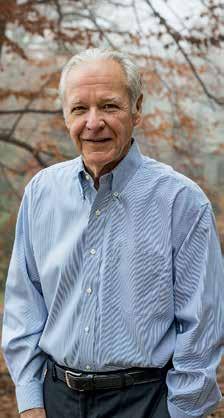
“The staff is incredibly efficient and friendly,” Besche said. “They’re very, very accomplished and they know what they’re doing. It’s absolutely amazing.”
Dr. Song said this new treatment has created high levels of collaboration among a wider range of medical experts, including radiation oncologists, who are responsible for the patient and overall treatment, and medical physicists, who oversee the technical aspects like maintenance and advancement of the MR-Linac machine. Also included are medical dosimetrists, who are responsible for generating treatment plans; radiation therapists, who set up the patients on the MR-Linac machine and deliver the treatment; and nurses, who are also responsible for the patient and assist the radiation oncologists.
Massey’s team has entered a small but growing community of those utilizing MRI-guided radiation around the world. It’s a collaborative network in which each entity shares and reports its research and evidence for patient
outcomes and technical issues, including future advances in the technology where Massey has a head start.
“Artificial intelligence is the wave of the future,” Dr. Song said. “We know it’s coming, but it takes validation, early adopters, people who need evidence. VCU is charging ahead at the early stage of this revolution.”
If you would like to support the innovative and compassionate patient care at VCU Massey Cancer Center, please contact Jasmine J. Davis, senior director of development with the Office of Medical Philanthropy and Alumni Relations, at 804-484-4903 or jjdavis3@vcu.edu.
Michael Besche described having no side effects following treatments at VCU Massey Cancer Center, one of 23 programs nationally that use MRI-guided radiation therapy.
PERSPECTIVE MCV FOUNDATION 5
Photo: Stephen Voss
PATIENT
Cancer Treatment Goes Viral
VCU researchers have engineered a virus to target and kill cancer cells.
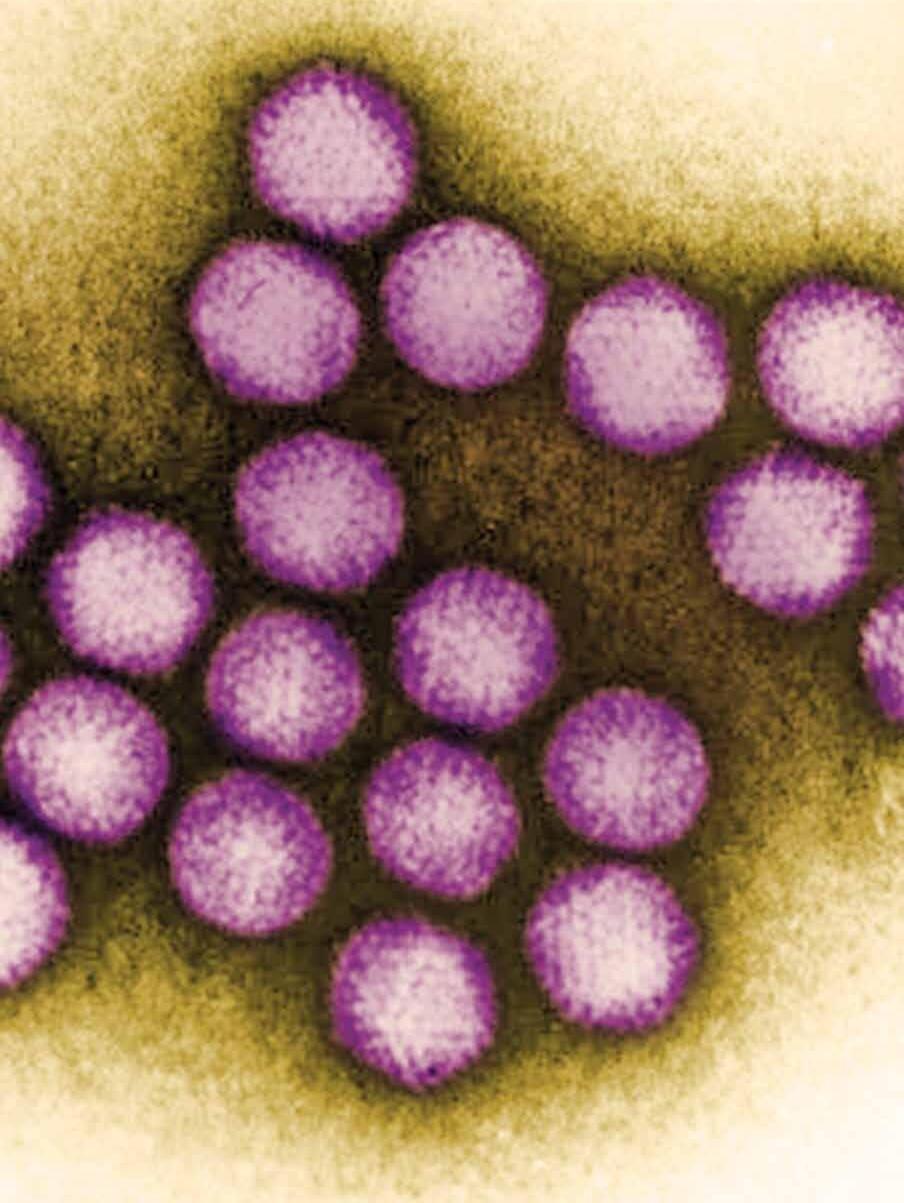 By Paul Brockwell Jr.
By Paul Brockwell Jr.
Cancer cells are often hard to target effectively. By their nature, the unchecked growth of tumors sends them silently spreading throughout the body, replicating and continuing to change and evolve genetically. Tumor cells, if they are not already resistant to traditional treatments like chemotherapy and radiation, may be growing in areas of the body where surgical intervention is too risky or impossible. Those pernicious challenges have inspired VCU researchers to create a treatment that can specifically target and destroy cancer cells without harming healthy cells.
Similar approaches have used the body’s own immune cells to target cancer, but in this scenario, imagine a deadly agent dispatched — like a heat-seeking missile — to selectively take out problem cells that have transformed into cancerous growth engines. Once the initial scuffle of a viral takedown begins, the byproducts of an immune response — the cytokines the body secretes to coordinate further assistance — stay on the scene, stamping out surrounding cancerous cells and securing the perimeter.
That imagined scenario may be a reality soon, thanks to several researchers at the VCU Institute of Molecular Medicine (VIMM) led by Paul B. Fisher, M.P.H., Ph.D., FNAI, professor and chair of the Department of Human and Molecular Genetics in the VCU School of Medicine and the Thelma Newmeyer Corman Chair in Cancer Research at VCU Massey Cancer Center. Dr. Fisher founded the VIMM at the VCU School of Medicine and has served as its director since 2008. He also co-founded the Cancer Molecular Genetics research program at Massey and co-led it as program leader for nine years.
“I’m really excited about discovering and understanding how molecules control complex biological processes,” Dr. Fisher said. “Seeing our novel molecules translate into lifesaving cancer treatment is a major accomplishment and the most rewarding part of my work.”
Dr. Fisher’s team has engineered adenoviruses that contain parts of two different adenoviruses, serotype 5 and serotype 3 (Ad.5/3), to selectively target cancer cells. Normally, adenoviruses are known for causing the common cold in humans, but their modified viral agent (Ad.5/3) has an enhanced ability to infect cancer cells where replication of the virus is controlled by a gene region called a promoter that is cancer-selective in its expression. In normal cells, this promoter gene is inactive and will not send the virus’s replication into hyperdrive. In cancer cells, the promoter gene is switched on and attacks the tumor cells by replicating with abandon, bursting out of the cell and seeking out additional cellular victims nearby and at a distance.

MCV FOUNDATION 7
Image: Centers for Disease Control and Prevention / Dr. G. William Gary Jr.
To enhance cancer-selective therapy with Ad.5/3, Dr. Fisher’s team created a two-part cancer terminator virus (CTV). In addition to cancer-specific virus replication the CTV selectively expresses a gene producing a secreted protein, the cytokine interleukin 24 (IL-24), which can uniquely kill cancer cells locally and at a distance, inhibit new tumor blood vessel formation, make chemotherapy and immune therapy work better, and stimulate the immune system to produce a memory effect that prevents tumor regrowth. This treatment method with a novel CTV delivers a one-two punch: First, the virus attacks, replicates and causes cell death in tumorous cells. A second promoter gene selectively drives production of IL-24 when viral replication is induced. Like calling for backup support, this cytokine deploys additional immune responses to tumor cells nearby while avoiding healthy cells and attacks cancer cells at a distance, including tumor cells that have spread (metastasized) to other sites in the body.
–
Cancer Cell Infection at Higher Efficiency
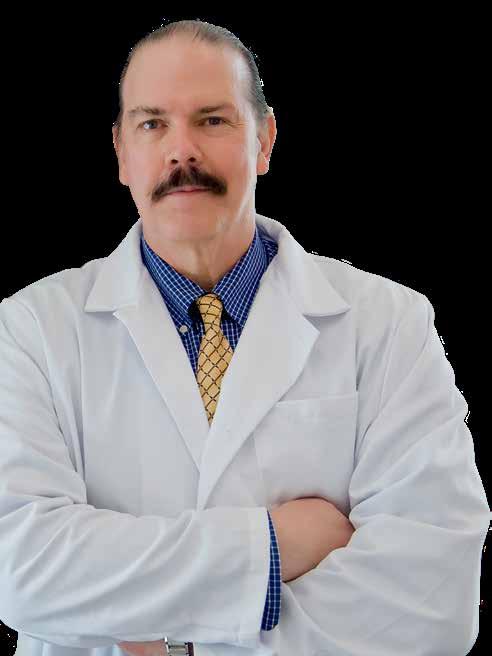
Engineered combination of two viruses allows three modes of attack.
Tropism Modified (Ad.5/3)
Enhanced Infectivity
Using Multiple Receptors: – CAR
– Desmoglein – CD-36
–
The team combined elements of Type 3 and 5 adenoviruses to engineer a viral agent that has increased infectivity by leveraging three different receptors to aid its attack on tumor cells.
Illustration: InterLeukin Combinatorial Therapies Inc.
Type 5 Adenovirus (Ad.5)
Coxsackie-Adenovirus Receptor (CAR)
Type 3 Adenovirus (Ad.3)
Desmoglein 2 – CD-46
The researchers started by looking at the limiting factors preventing the body’s normal immune processes from working better, and they eventually identified research that could translate to a clinical setting by focusing on how to perfect cancertargeting viruses using a novel delivery method.
Paul B. Fisher, M.P.H., Ph.D., FNAI, is leading a team of researchers to develop the next generation of cancer-targeting viral therapies.
8 WINTER 2023
Photo: VCU Massey Cancer Center
The biggest benefit of this approach, said Dr. Fisher, is that the CTV is genetically agnostic. Cancer is notorious for shape-shifting, evolving and mutating in ways that allow it to outwit current treatments, but those tactics would not allow it to escape or out-morph the cancertargeting viral agent and its trusty cytokine sidekick, IL-24.
The researchers started by looking at the limiting factors preventing the body’s normal immune processes from working better, and eventually identified research that could translate to a clinical setting by focusing on how to perfect cancer-targeting viruses using a novel delivery method.
The biggest challenges for this approach when delivering cancer-targeting viruses into circulation has been figuring out how to sneak past the body’s immune system and
prevent nonspecific trapping in the liver. Dr. Fisher and his team also needed to find a way to deliver these viral hunters without triggering the alarms on the body’s internal immune system.
Slipping past security requires a new take on the Trojan horse. To do that, the cancer-targeting viral particles (CTVs) are encased in microbubbles that protect the virus from being identified and targeted by the body’s natural immune response before it can attack the tumor cells. When the injection is complete, targeted ultrasound vibrations burst the microbubbles open and release the virus to do its work.

As discussed above, the researchers have also engineered IL-24 — an immune system byproduct — into the virus (Ad.5/3-CTV) to tackle uninfected cells in the surrounding area and at a distance. IL-24’s secretion generates additional cancer-killing properties and goes off like a signal flare to dispatch other immune cells to target nearby cancer cells. While the release of infectious virus by the initially infected tumors cells is restricted over time by the immune system, IL-24 can circulate through the body, induce its own synthesis and selectively kill tumor cells directly and through enhancement of the body’s immune responses.
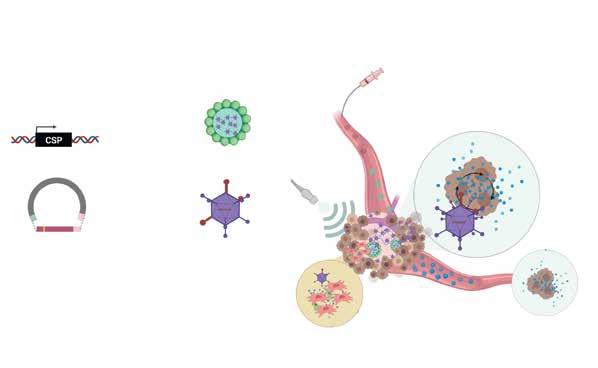
In 2020, Dr. Fisher and Devanand Sarkar, Ph.D., worked with VCU Innovation Gateway to patent a new class of cancer-targeting adenoviruses (Ad.5/3-CTV) they worked on together. A crucial part of the process, Dr. Fisher said, was securing the intellectual property protections for the
The engineered virus is entrapped inside microbubbles (1) before being delivered into the body (2). This allows it to evade the body’s natural immune response, which would attack the viral therapeutic. Targeted ultrasound helps break open the microbubbles (3) and releases the novel virus and molecular reagents, which then can selectively target and attack cancer cells.
Cancer Specific Promoter, e.g. PEG, GAPE Designer Cytokine M7S or IL-24S Ad.5/3-CTV No Cytotoxicity Novel Molecular Reagent(s) Virus-Based Therapy (2) Systemic Delivery of Adenovirus Distant Tumor Local Tumor Non-Transformed Cell (1) Microbubble entrapped Ads (3) Ultrasound Strategy for Effectively Destroying Local and Disseminated (Metastatic) Cancers
MCV FOUNDATION 9
Illustration courtesy of Swadesh K. Das, Ph.D.
team’s work on the adenovirus with a patent along with the system for delivering the virus and its designer cytokine byproduct left to clean house on tumor cells. Ad.5/3-CTV, ILCT-5307 has been exclusively licensed to a biotechnology startup company, InterLeukin Combinatorial Therapies Inc., to bring this novel therapeutic into the clinic to treat patients with recurrent glioblastoma (GBM), an invariably fatal cancer without any effective therapy.
WHAT’S NEXT?
Dr. Fisher and his team hope that cancer-targeting viruses and the designer cytokine treatments will have a diversity of applications across specific cancer types where traditional treatments might fail. They have published on melanoma, breast cancer, prostate cancer, neuroblastoma, colorectal carcinoma, ovarian cancer and glioblastoma. To date, they have not found a cancer resistant to the promoter gene being expressed to target viruses to replicate in tumor cells.
Last year, they began preclinical studies using a contract research organization to evaluate any potential toxicity of Ad.5/3-CTV (ILCT-5307) when injected in the brains of animal models. No toxicity or behavioral changes were observed and the same protocol will initially be used to treat human patients with glioblastomas. In preclinical animal models, a single injection of the virus cured 50% of animals. These strong results are the culmination of years of work in the lab.
“Science is an iterative, progressive process,” Dr. Fisher said. “It takes minutes or seconds to identify a gene that may be important, but it can take a lifetime to understand how that gene works.”
It’s a pivotal moment, Dr. Fisher said, when years of basic science research are on the cusp of being translated into clinical applications. He also shared how important colleagues like Dr. Sarkar; Shawn Wang, Ph.D.; Luni Emdad, Ph.D.; and Swadesh K. Das, Ph.D., have been to the progress. Dr. Wang co-leads the Developmental Therapeutics Group at Massey and is associate director of immunology in VIMM. Drs. Emdad and Das are associate professors in human and molecular genetics and affiliated with Massey and the Institute for Molecular Medicine. Their research collaboration has moved the project forward on the
MCV Campus and positioned the research to be an early success story of the Molecules to Medicine Program at VCU Massey Cancer Center.
The project received critical early funding from the National Foundation for Cancer Research for work in the lab, and private philanthropy helped finance the preclinical studies. The team is now raising money to complete the clinical trials, and they’ve received interest from multiple institutions across the U.S. Glioblastomas, one of their early targets, are an aggressive form of brain cancer that is relatively rare compared to other cancers in the body. That reality makes partnering with other institutions like M.D. Anderson, Johns Hopkins and Northwestern necessary to recruit adequate numbers of patients with recurrent glioblastomas. The Ad.5/3-CTV is also effective against brain tumors that originally develop outside the brain and then metastasize, which account for 30% to 40% of brain tumors. This potentially expands the scope and utility of therapeutic viruses in patients with both primary brain tumors (GBM) or secondary brain tumors (a consequence of metastasis from organs outside the brain).
From here, the team hopes to enter clinical trials with its cancer-targeting viruses, but its long-term vision includes examining and developing other candidates for designer viruses and designer cytokines that can help tackle liver and pancreatic cancers, as well as other hard-to-treat or resistant tumors by leveraging the viruses that can selectively strike cancer cells. Team members also could see the potential for genetically modifying other immune cells in patients to attack cancers and work in concert with other therapies to drive better patient outcomes.
“We’re extremely excited and optimistic about where this research is going,” Dr. Fisher said. “This could be a major game changer and a paradigm shift in how aggressive and metastatic cancers are treated clinically.”
If you are interested in supporting this research effort at VCU Massey Cancer Center, please contact Jasmine J. Davis, senior director of development with the Office of Medical Philanthropy and Alumni Relations, at 804-484-4903 or jjdavis3@vcu.edu.
10 WINTER 2023
Dr. Fisher and his team hope that cancer-targeting viruses and the designer cytokine treatments will have a diversity of applications across specific cancer types where traditional treatments might fail.
MOLECULES TO MEDICINE
The work of VCU Massey Cancer Center’s researchers to discover new cancer treatments is an inherently collaborative effort on the MCV Campus. Massey’s designation by the National Cancer Institute places it in the top 4% of cancer centers nationally. It produces paradigm-shifting research, training and excellent care. A key strategic priority for Massey is increasing access to new therapies and clinical trials for early-phase treatments.
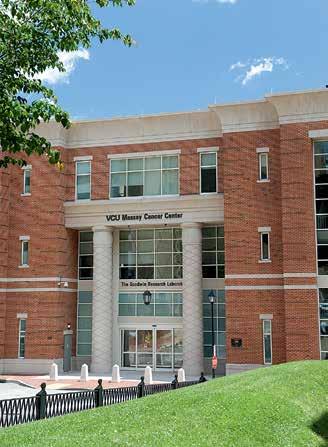
“It’s very important for us to take our own discoveries from the laboratory to the bedside in clinical trials and into the community,” said Saïd Sebti, Ph.D., professor of pharmacology and toxicology and Massey’s associate director for basic research. “We’re very excited about our Molecules to Medicine efforts, and we are thrilled about the potential impact on improving the lives of cancer patients. Our goal is to see solutions going from the lab to the clinic to our community so we can help cancer patients here in Central Virginia and around the world.”
Through an innovative, cross-campus collaboration with B. Frank Gupton, Ph.D., the Floyd D. Gottwald Professor and Chair of the Department of Chemical and Life Science Engineering in the VCU College of Engineering, researchers are able to produce the needed supply of their own molecules for research and testing. Dr. Gupton is an affiliated researcher with Massey and is helping with a pilot program to strengthen collaborations between basic researchers and primary investigators focused on translational research in the areas of cancer biology, cancer immunology and cancer immunotherapy with the goal of developing biological agents to treat cancer.
The focus of these pilot projects is on identifying essential pathways for survival, invasion or metastasis and tumor interactions with stromal cells or immune cells with the hopes that insights will lead to the development of biologic agents like viruses or other approaches with translational potential. Massey’s director, Robert Winn, M.D., is enthusiastic about the potential that Massey’s collaboration with Dr. Gupton’s Medicines for All research center holds for making new cancer discoveries.
“Molecules to Medicine gives our researchers a new means for translating and advancing their scientific discoveries from the laboratory into clinical trials,” Dr. Winn said. “Continuing to strengthen this unique collaboration will enhance and expedite our ability to develop novel therapies and bring them to cancer patients and our community.”
“It’s very important for us to take our own discoveries from the laboratory to the bedside in clinical trials and into the community.”
Saïd Sebti, Ph.D., professor of pharmacology and toxicology and Massey’s associate director for basic research
MCV FOUNDATION 11
A

lethal dose of fentanyl is only a few milligrams.
Fighting Fentanyl
VCU Health’s position as a global leader in fighting opioid use disorder includes recent efforts to reverse the toxicity of a potent synthetic opioid, and the university’s strength in addiction research continues to drive innovation in treatment programs.
By Holly Prestidge
MCV FOUNDATION 13
An individual arrives at a busy hospital emergency room experiencing a drug overdose. Their skin is cold and clammy. If they’re even conscious, they’re shaking uncontrollably and have trouble breathing. They’re confused and can’t focus on what’s happening to them.
Fast-acting doctors and nurses suspect opioids, possibly fentanyl, and administer naloxone, a common opioid antagonist used in the emergency treatment of overdoses.
Naloxone is effective, but it’s a short-acting agent and wears off quickly, sometimes in less than an hour. Fentanyl, on the other hand, a powerful synthetic opioid, can linger in the body for much longer. Additional doses of naloxone are sometimes necessary to continue to fight off the residual waves of respiratory depression caused by fentanyl, but administration and timing are crucial.
Naloxone, while lifesaving, can also produce acute opioid withdrawal symptoms that sometimes lead people who’ve overdosed before to take their chances and refuse further treatment rather than dealing with its side effects.
If the patient seems stable and leaves the hospital, or the naloxone dosage wasn’t enough the first time — or the hospital runs out of the drug — there’s a chance the patient may die.
VCU Health researchers and scientists are charging ahead to find the answer to a decades-old opioid crisis that, in Virginia, now claims more lives than automobile accidents and guns combined.
Their efforts are critical.
A recent Washington Post report, citing 2021 data from the Centers for Disease Control and Prevention, revealed that fentanyl kills more adults ages 18 to 49 nationally than car accidents, suicides, guns or falls.
The dramatic rise in synthetic opioid-related deaths that started during COVID-19 spurred several actions by the federal government, including a $1.5 billion aid package announced last fall that provides, among other things, increasing access to overdose medicines like naloxone for first responders.
That was followed by the announcement in late 2022 of a new website that would be updated every two weeks with nonfatal opioid overdose data, collected at the county level in all 50 states from EMS first responders. Joining that fight is Yan Zhang, Ph.D., professor of medicinal chemistry at the VCU School of Pharmacy and member of the VCU Institute for Drug and Alcohol Studies. In July 2022, he was awarded a $2.8 million grant from the National Institute on Drug Abuse to advance his research into the development of specific opioid receptor antagonists that would reverse the acute and chronic toxicity of fentanyl.
His grant underscores VCU’s status as a leading research institution for opioid use disorder. Last year, VCU was awarded $16.5 million in NIDA funding, placing it 18th nationally.
Source: Centers for Disease Control and Prevention, National Center for Health Statistics (2021)
While he has dozens of research grants to his name, this one is Dr. Zhang’s second grant in recent years pertaining to opioid use disorder. He received an NIH/NIDA grant in 2019, worth just over $2 million, for development of novel mu opioid receptor modulators, with the goal of conducting preclinical studies on several novel lead compounds for opioid use disorder treatment. Mu receptors are among a family of critical proteins in the body that modulate pain, but major side
(1999–2020)
National Overdose Deaths Involving Any Opioid
60,000 80,000 40,000 20,000 1999 2000 2001 2002 2003 2008 2013 2004 2009 2014 2005 2010 2015 2018 2006 2011 2016 2019 2007 2012 2017 2020 2010: 21,089 2020: 68,630 2017: 47,600 Total Men Women 14 WINTER 2023
effects from the application of common mu opioid receptor agonists — such as morphine and fentanyl — are abuse and addiction, and even overdose.
“We want to develop a more effective treatment for fentanyl overdoses that tackles the interaction between fentanyl and mu opioid receptors,” Dr. Zhang said of his most recent grant.
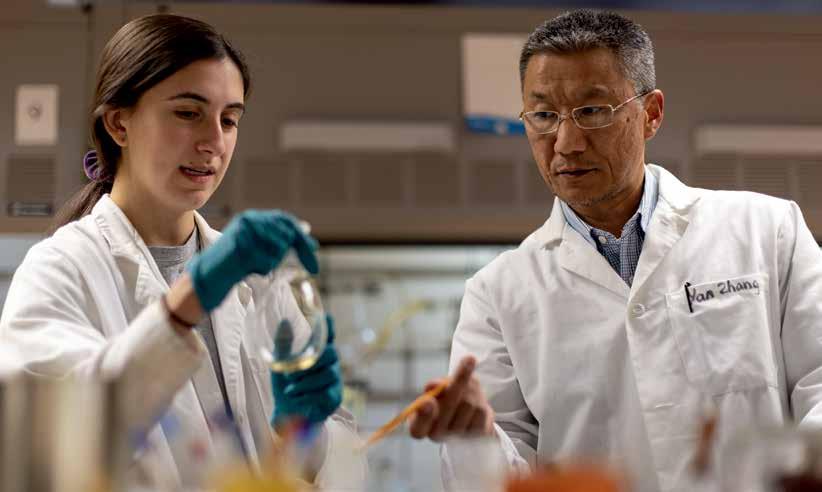
POTENT PROBLEM
Fentanyl packs a dangerous punch. It’s 100 times more potent than morphine and at least 30 times more potent than heroin.
It’s often reserved to treat the most severe cases of acute and chronic pain. Like other opioids, fentanyl targets mainly mu opioid receptors, which are found on cells throughout the body. When opioids attach themselves to these receptors, they block the body’s pain receptors in the brain, stimulating its pain management mechanisms. They also send waves of dopamine into the brain, creating feelings of euphoria — the sort of high that leads patients to addiction. Medical supervision is imperative, as a few milligrams of fentanyl are enough to kill an adult. Research shows that as little as one week’s worth of fentanyl can lead to addiction, especially for those who may be genetically predisposed to it.
Yet for many who use opioids outside of a doctor’s watchful eye, access is as easy as ordering the drugs by mail, and use can lead to a variety of side effects including death.
Opioid misuse can produce a variety of gastrointestinal issues such as nausea and vomiting, along with fatigue. But the most serious side effect is respiratory depression — shallow breathing and an irregular or slow heartbeat — which can lead to death, said Dr. Zhang.
He described the opioid crisis as needing a three-pronged solution. In layman’s terms, he said, that’s improving lives, changing lives and saving lives.
Fentanyl
30x stronger than heroin
100x stronger than morphine
107,622 died of drug overdoses in the U.S. in 2021.
Fentanyl was responsible for two-thirds of those deaths.
Source: Washington Post “Cartel Rx” series, December 2022
Rachael Flammia works with Yan Zhang, Ph.D., in his lab. Dr. Zhang is studying the development of a means to reverse the acute and chronic toxicity of fentanyl, a synthetic opioid that is 30 times more potent than heroin and 100 times more potent than morphine.
MCV FOUNDATION 15
Photo: Tyler Trumbo, MCV Foundation
Improving lives means finding effective, nonaddictive pain management medications that minimize the risk of addiction when individuals are first introduced to opioids, usually as patients in the hospital.
The grants he’s secured, however, support research for the other two stages — changing and saving lives. He explained that changing lives means developing effective medications for those who are already addicted but working through therapy. His 2019 grant supported this research.
His current research focuses on the direst stage of the crisis — the overdose. He’s working to develop a chemical counteragent that will block fentanyl’s ability to attach itself to the mu opioid receptors. Part of the challenge is tackling not only fentanyl’s toxicity, but also polysubstance abuse addiction, where fentanyl is mixed with other opioids.
Overdose deaths involving fentanyl often occur not from fentanyl alone — it’s often added to other street drugs, unbeknownst to users.
“When they are mixed together, the scenarios can be very difficult to tackle as researchers,” Dr. Zhang said. “If you make something that responds to fentanyl, it will also have to respond to other substances that the fentanyl is mixed with.”
Zhang is working with an expert team at VCU and VCU Health of chemists, biologists and pharmacologists. Within that team is psychiatrist and addiction expert F. Gerard “Gerry” Moeller, M.D., director of VCU’s Wright Center for Clinical and Translational Research and the university’s associate vice president for clinical research. Dr. Moeller also leads the VCU Institute for Drug and Alcohol Studies.
Dr. Moeller echoed Dr. Zhang, in that increasingly today, overdoses often have a common element: the presence of fentanyl.
“Fentanyl is really potent so if you’re not tolerant to opioids, it’s very easy to overdose,” Dr. Moeller said. “Fentanyl can be put into other things in really small amounts and have a big effect.
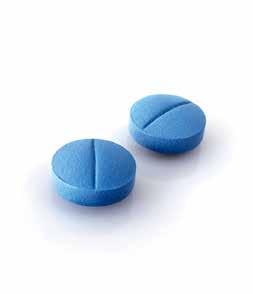
“We’re seeing overdose deaths with cocaine, for example, but it’s not from the cocaine itself,” he added. “It’s the fentanyl being added to the cocaine.”
Naloxone is the go-to medication for overdoses, but it has its limitations, Dr. Zhang said.
“Your body metabolizes very quickly so the naloxone will disappear, but the fentanyl lives on in your body, maybe for several hours,” Dr. Zhang said, “which means you have to be given multiple doses of naloxone.”
The danger doesn’t go away once an individual survives an overdose. In fact, it’s the opposite. After one overdose, “the odds of you having a repeat overdose and dying are really high,” Dr. Moeller said.
LEADING THE WAY
In April 2017, VCU Health opened the Multidisciplinary Outpatient Intensive Addiction Treatment Clinic, or the MOTIVATE Clinic, as it’s called, in Richmond’s Jackson Ward community. The facility helps those who are struggling with addiction, many of them referred to the clinic from nearby VCU Medical Center after an overdose.
According to the Centers for Disease Control and Prevention, in 2021, more than 80,000 people died from opioid overdoses nationally, a statistic fueled, in part, by a worldwide pandemic.
16 WINTER 2023
Part of the challenge is tackling not only fentanyl’s toxicity, but also polysubstance abuse addiction, where fentanyl is mixed with other opioids.
“The stress of COVID, including the loss of employment and other factors, led to an increase in substance abuse, which led to increases in opioid use and overdoses,” Dr. Moeller said.
Compounding the problem was a lack of access to treatment, as clinics and treatment facilities initially shuttered their doors at the onset of the pandemic. But by the time COVID-19 struck in early 2020, VCU was nearly three years into a groundbreaking program that was already changing the local landscape in the treatment of opioid use disorder for both patients and medical personnel.
The MOTIVATE Clinic’s novelty lies in its approach: Rather than patients leaving hospitals and being referred to outside agencies for treatment, where they can sometimes get lost or lose interest when left to initiate treatment on their own, MOTIVATE links emergency services directly to a treatment facility.
That straight line within the same health system has proved effective and is further enhanced by thoughtful programs that approach treatment from two different areas: medication, with patients treated with buprenorphine, which reduces cravings for opioids, but also behavioral and counseling services.
By June 2017, a few months after opening, the clinic had reached upward of 80 people. Today, Dr. Moeller said, the clinic treats more than 400 people every month.
One key component that has contributed to the clinic’s success is the everexpanding group of health care professionals who understand that opioid use disorder affects everyone — from teens to pregnant women to seniors — and have incorporated addiction medicine into their roles. Within the MOTIVATE Clinic are social workers, physicians and nurses, but also general or family practitioners, OB/GYNs, internal medicine doctors and emergency medicine physicians.
WHAT’S NEXT?
VCU Health didn’t stop with the MOTIVATE Clinic. One of the few changes resulting from COVID-19 was a relaxing of federal regulatory policies regarding telehealth services, including allowing doctors to prescribe medications for opioid use disorder.
Under Dr. Moeller’s leadership, and with funding from a federal grant administered by the Virginia Department of Medical Assistance Services, the VCU Health Virtual Bridge Clinic was created in April 2021.
As its name implies, the virtual program is the invisible bridge between the emergency room and the MOTIVATE Clinic, so patients have a clear course of treatment available to them before they even leave the hospital.
Timing is everything.
“For patients with opioid use disorder, stress and depression and other factors means their motivation to engage in treatment fluctuates over time,” Dr. Moeller said. “So, if they’re ready to seek treatment while they’re in the emergency room, you need to be able to get them into treatment right away as opposed to giving them information and telling them to call, then wait on treatment that might be three or four weeks down the road. By that point, they may have had an overdose.”
With VCU Health Virtual Bridge Clinic, providers can get patients an appointment within 24 hours and to get them started on medication via telehealth.
“They don’t have to come in, they can be at home, they don’t have to find transportation,” Dr. Moeller said. “Then, we prescribe the medication and bridge
Psychiatrist and addiction expert F. Gerard “Gerry” Moeller, M.D., who leads the VCU Institute for Drug and Alcohol Studies, said VCU’s MOTIVATE Clinic, which opened in 2017, treats roughly 400 people every month who are struggling with addiction. Photo: VCU
Addiction Research Funding at VCU
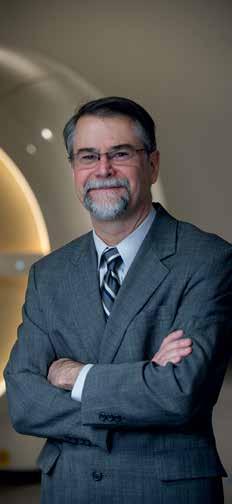
Nearly 14%
Increase From 2017 to 2021
VCU has received millions of dollars of NIH funding targeting addictions (NIDA and NIAAA). From 2017 to 2021, new and continued research funding increased from $20.8 million to $24.1 million.
MCV FOUNDATION 17
them all the way until they get into a face-to-face appointment. We’ve seen a lot of success with that.”
Dr. Moeller said the clinic has also received interest from the Virginia Department of Corrections, which is looking to bolster treatment programs for inmates with opioid use disorder.
“Of the people who made it into our bridge, almost 75% of them made it across,” he said, a significant step forward when compared with a system that requires patients to seek treatment on their own.
Going one step further, VCU is also working with Virginia’s Emergency Department Care Coordination Program, a statewide system that connects emergency rooms around the state by sharing information in real time about patients who receive emergency services.
“To my knowledge, there are very few places in the country or maybe the world that have the level of interaction and programs going on to target addictions and opioid use disorder,” he said. “It ranges from the science that Dr. Zhang is doing, creating chemicals in the lab, to getting FDA approval for medications, to getting them to patients through telehealth and working with emergency rooms and other agencies.”
Dr. Moeller said all these elements — from research capabilities and in-house programming to involvement in statewide initiatives — have positioned VCU as a global leader in combating addiction and specifically, opioid use disorder.
“There’s been a great shift in the history of the overuse of prescription opioids and that’s very positive,” Dr. Moeller said. “At VCU, we’re in the next phase, which is how do we treat the significant number of individuals who have opioid use disorder and keep them from becoming a statistic.”
If you would like to support addiction research at VCU, please contact Heather Phibbs, director of development for the neurosciences in the Office of Medical Philanthropy and Alumni Relations, at 804-628-8907 or heather.phibbs@vcuhealth.org.
Dr. Moeller said all these elements — from research capabilities and in-house programming to involvement in statewide initiatives — have positioned VCU as a global leader in combating addiction and specifically, opioid use disorder.
18 WINTER 2023
Fentanyl Molecular Structure
A Tradition of Training Addiction Experts
VCU’s longest-running grant approaches 50 years of supporting addiction research
Federal grants may have dollar values, but the impact they’ve created and continue to create for scientists battling the opioid epidemic is priceless.
Thanks to the efforts of one man — William L. Dewey, Ph.D., chair of the VCU School of Medicine’s Department of Pharmacology and Toxicology and a faculty member since 1972 — the department has been the recipient of a National Institute on Drug Abuse training grant continually since 1976.
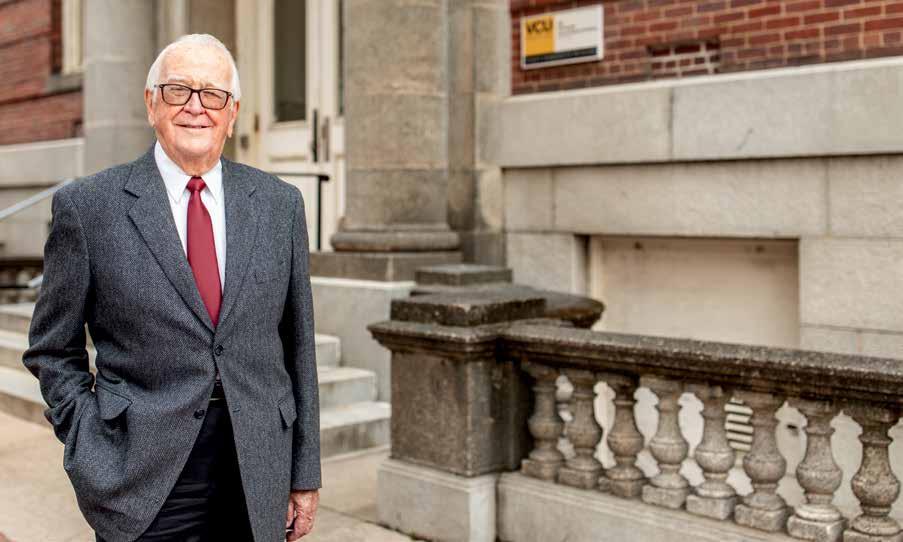
The 10th renewal last summer, effectively securing funding through 2026, stands as NIDA’s — and VCU’s — longest-funded institutional grant.
Dr. Dewey sought the grant during the mid-1970s to support predoctoral and postdoctoral pharmacologists’ training in addiction research. He diligently renewed the grant every five years.
Now collectively worth upward of $24 million, it’s helped hundreds of students and trainees with tuition, equipment and supplies, not to mention positioning VCU’s pharmacology and toxicology programs as among the nation’s best for addiction research.
“It’s way more than just the science that’s important — it’s improving people’s lives,” Dr. Dewey said, noting that the stakes couldn’t be higher. Opioid overdoses account for upward of 100,000 deaths annually.
“You never know what the people we educate will contribute,” he said. “It would be great if one of them developed the drug that stopped addiction.”
William L. Dewey, Ph.D., chair of VCU’s Department of Pharmacology and Toxicology for the last 14 years and a faculty member since 1972, sought and then renewed a National Institute on Drug Abuse training grant continuously for 50 years. It’s NIDA’s and VCU’s longestfunded institutional grant, which to date has supported hundreds of predoctoral and postdoctoral students’ tuition, equipment and supplies.
Photo: DeAudrea “Sha” Aguado, VCU School of Medicine
“It’s way more than just the science that’s important — it’s improving people’s lives.”
MCV FOUNDATION 19
William L. Dewey, Ph.D.,
chair of VCU’s Department of Pharmacology
and Toxicology
Compassion Warmth

As the country’s oldest civilian burn center, VCU Health’s Evans-Haynes Burn Center celebrates 75 years of testing and developing the best standards of care.
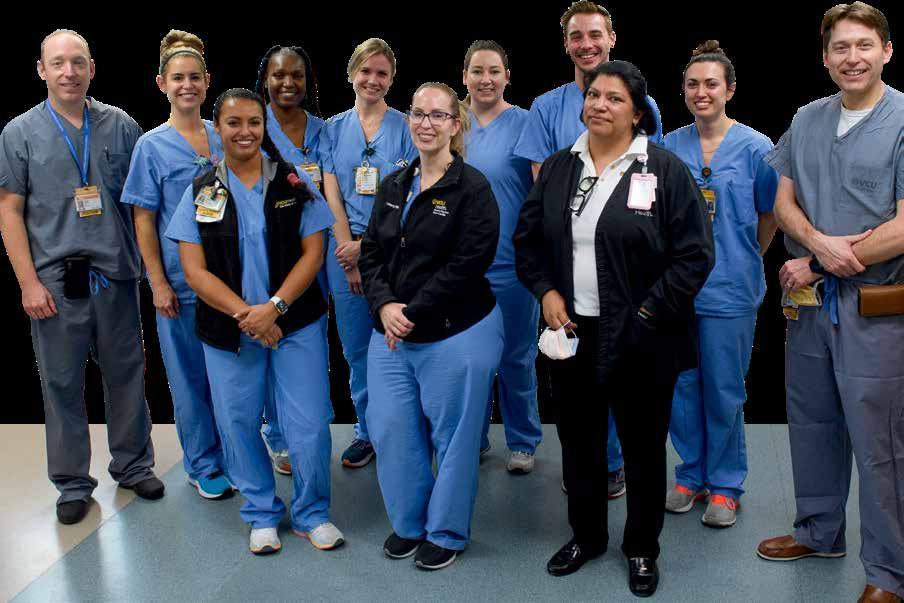 By Paul Brockwell Jr. and Danielle Pierce
By Paul Brockwell Jr. and Danielle Pierce
The cool, blue and white hues of a large wintry painting are among the first things that visitors see when entering the eighth-floor burn unit at VCU Medical Center’s Critical Care Hospital. The choice was intentional: a piece with calming colors that are the opposite of fire and heat.
Sending a message through artwork is among the many details that the Evans-Haynes Burn Center has carefully managed in order to create a best-in-class center for treating patients with severe burns. Evans-Haynes is not only the oldest civilian burn unit in the country, it is also one of the best. It’s the only burn center in Virginia to be verified four times by the American Burn Association, whose rigorous evaluation process ensures continuous improvement and a growth mindset among the team. It’s worth noting that VCU Health’s burn center predates by 20 years the establishment of the American Burn Association, a professional organization dedicated to improving the lives of burn patients. It offers national verification based on patient safety and outcomes along with a commitment to innovation and research.
“Our patients get everything they need right here under one roof — pain team, therapists, nursing staff, reconstructive and plastic surgeons, burn-specific anesthesia and doctors whose care and expertise complement each other,” said Michael Feldman, M.D., the burn center’s medical director and the B.W. Haynes Jr., M.D., Endowed Professor at the VCU School of Medicine. “I think that’s part of what makes this burn center special — we offer the full gamut of what our patients need.”
Each year, the center — with 16 total beds — treats 600 to 650 pediatric and adult patients for acute burns and reconstructive needs. Half of the unit capacity is dedicated to intensive care patients. The center’s nurses and doctors help heal people injured from fire, chemical agents, scalds and electrical burns.
The center was established in 1947 by Everett I. Evans, M.D. During Dr. Evans’ tenure as burn director, many advances in burn care were developed, including the first

civilian intensive care unit and the first protocol for fluid resuscitation post-burn. Drs. Evans and Haynes also were early thought leaders in managing mass casualty events involving civilians. After Dr. Evans’ death, Boyd W. Haynes, M.D., directed the burn center for 36 years. Dr. Feldman became director in 2011.
“There’s a lot of people here who are passionate about burn care, who want to help people and have put extra time in to train and to learn how to use special products and how to treat these wounds and so much more,” Dr. Feldman said. “It’s something that takes a lot of time and a lot of training. And it just takes a passionate group of people to make it work.”
In addition to the direct nursing teams and physicians, Dr. Feldman credits a host of specialists who are critical for successful patient outcomes. This includes radiologists, surgical techs, lab personnel, environmental services staff, infection specialists and personnel in the supplies and equipment departments. The environmental services staff are critical to preventing infection, given the high risk. Frequent cleaning and special protocols with ultraviolet lights help mitigate the risk of multidrug-resistant bacteria and keep patients safe. Around every corner of the ward there is easy access to hand sanitizer, which staff use noticeably more frequently when roaming the floor.
“When we think of burn care, we are often thinking of our front-line workers and they are so important, but just as important are those who work tirelessly behind the scenes,” said Beth Broering, trauma and burn program manager. “Without their unrivaled commitment to our patients and their work in the environment, we would not have the outcomes we have.”
“On average, we’ve been able to reduce length of stay and to improve rates of healing because we offer the newest technology in terms of skin substitutes,” Dr. Feldman said. “Charlie Xavier’s story [see page 24] is a great example of how our abilities can help patients achieve outcomes even beyond our expectations and estimates.” The burn center
MCV FOUNDATION 21
Burn care requires multidisciplinary teams that include radiologists, surgical techs, lab personnel, environmental services staff, infection specialists, as well as psychologists and nutritionists who help guide care. Photos: Thomas Kojcsich, VCU
space has been specifically designed to optimize care. “Patients who lose skin due to burns often must be kept in warmer rooms to ensure their safety and recovery,” Dr. Feldman said. “You can imagine if you don’t have skin, you get cold very quickly and that can cause lots of problems.”
Keeping rooms at temperatures in the upper 80s is one element that makes burn care unique. Traditional burn treatment is also intensive for the patient and often involves using skin grafts, a procedure in which providers take healthy skin from one part of the body and move it to cover skin that’s damaged or missing. But in extreme cases, there isn’t enough healthy skin to help repair a burn wound.
When this happens, providers look for a piece of healthy skin that can be sent off to a lab where they will grow new skin. This process can take weeks and must take place over and over again until they get enough skin to heal the wounds. It takes patience, dedication and passion to help those whose lives have been upended and scarred by flames.
“Taking care of burn patients is the ultimate honor as a surgeon,” Dr. Feldman said. “You care for adults and children, and then you get to follow these patients for sometimes their entire life and watch them grow up if they’re children. You become a part of the family.”
OLD, BUT BOLD: PATIENT-CENTERED RESEARCH
Evans-Haynes continues to have a robust level of research aimed at improving patient outcomes. Newer technology like RECELL ® can speed up the healing process. Providers
Healing With RECELL in Three Steps 3
can take a smaller piece of skin and process it in the operating room without ever having to send it out to a lab. RECELL is an innovative, clinically proven approach for thermal burn treatment that VCU Health helped test in adult and pediatric care. Some of the early trials were so successful, they ended early.
“Evans-Haynes was part of the burn centers who participated in the development of this product, and it really is quite amazing,” Dr. Feldman said. “There is no downtime, no waiting for the lab to send the skin back to you. I can process it in the operating room and then apply it right away — this is unheard of.”
The process starts by taking a small sample of the patient’s skin and putting it into a device that mixes the sample with a special enzyme mixture that separates out the individual skin cells responsible for skin proliferation, healing and pigmentation. The cells are put into a suspension that is then sprayed on a wound. A 1-squarecentimeter sample can be used to cover 80 square centimeters of wound.
The technology is incredibly effective in reducing the amount of donor skin needed to be harvested to use in grafting. It can help decrease pain and scarring of wounds. With fewer surgical procedures and less downtime, it reduces the time it takes patients to heal and recover and allows patients to leave the hospital sooner.
Dr. Feldman sees the evolution of care going even further through some basic science research, including projects aimed at figuring out how to reduce or stop wound
1. Take a small skin sample Your doctor will take a small piece of your own healthy skin.
2. Prepare the cells In the RECELL Device, your cells will be separated from one another to form a liquid spray.
22 WINTER 2023
3. Spray the cells on The liquid is then sprayed onto the burn wound or on top of a meshed skin graft.
3.
Instructions for Use. RECELL® Autologous Cell Harvesting Device. Illustration: RECELL® Patient Guide
conversion, or when over time a second-degree burn intensifies to a third-degree burn or becomes infected. In the not-too-distant future, burn care could entail using stem cell technology or 3D printing to create skin grafts using a patient’s genetic material.
“The future of burn care is only limited by our imagination,” Dr. Feldman said, “and our desire to make burn care better.”
Research also has focused on addressing burnout among care providers. Wound care can be emotionally draining for caregivers. To prevent infection requires a frequency of cleaning and dressing the burn wounds, which is both painful and necessary to prevent complications once the skin’s outer layer of protection has been compromised through injury.
A recent project led by nurse clinician Tiffany Lord, D.N.P., developed a virtual reality program to help reduce the emotional toll that wound care has on care providers. Patients could immerse themselves in a relaxing scene using virtual reality goggles while receiving wound care. Later, Dr. Lord learned her colleagues on the nursing staff also found the technology helpful on breaks from their everyday work, especially during the added stress of the pandemic.
WHAT’S NEXT?
As VCU Health’s burn center prepares to celebrate its 75th year, its longevity has only strengthened resolve among the team to continue to pursue promising research that can help ease burn patient suffering or accelerate healing. Equally important is ensuring that tomorrow’s patients will have trained providers who can provide specialized care to burn victims.
Even today, the need has been growing. During the COVID-19 pandemic, Evans-Haynes saw a 40% increase in its patient census over the previous two years, including a 12% increase in pediatric patients as families stayed home during lockdowns.
“We have the only burn fellowship in the Commonwealth,” Dr. Feldman said. “We are the only outfit training future burn surgeons in Virginia, which is impressive, but also very necessary with an increasing number of burn patients.
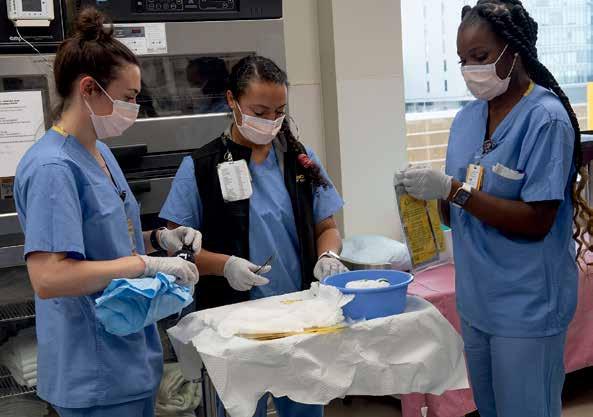
We need more people who know what they’re doing and how to take care of burns.”
Dr. Feldman also appreciates firsthand the importance of mentorship in inspiring the next generation of burn care specialists. An invitation to scrub in on a case during his time as a medical student on the MCV Campus is what ignited Dr. Feldman’s passion for burn care when observing and assisting on a case involving an artificial skin product.
“It’s all about the people you meet early in your career,” Dr. Feldman said. “I met mentors who were very enthusiastic and good teachers, and they molded me into my current career. They were academic surgeons at their heart, and I knew that’s what I wanted to be, too. My hope is that we can strengthen our fellowship program into the first American Burn Association-verified fellowship program in Virginia, continue to evolve our offerings, along with making sure we uphold the highest standard of care to our patients while they’re most vulnerable.”
If you are interested in supporting the work of the EvansHaynes Burn Center at VCU Health, contact Nathan Bick, senior director of development in the Office of Medical Philanthropy and Alumni Relations, at 804-827-0387 or nathan.bick@vcuhealth.org.
MCV FOUNDATION 23
Registered nurses Emily Smith (left) and Jinah Quitter (center) work with De De Larsey (right), a care partner, to prepare supplies for wound care at the VCU Health Evans-Haynes Burn Center.
Beating the Odds with the Help of the Evans-Haynes Burn Center
On Sept. 10, 2021, a horrific workplace accident left Charlie Anne Xavier fighting for her life. She was admitted to VCU Health’s Evans-Haynes Burn Center with third-degree burns over 85% of her body and a very low chance of survival.
But Charlie — a mother of two young boys — knew that she had to fight with everything in her to make it home to her family. And fight she did. After more than 170 days in the hospital, over 50 surgeries and countless wound treatments, Charlie left the Burn Center to return home — six months earlier than anticipated.
“The team at the burn center is phenomenal and they saved my life,” Xavier said. “Dr. Feldman pieced me back together, and I found the strength to pull through. I kept fighting. I never lost hope. And I was determined to get back home and be a mother to my boys.”
“Charlie had one of the worst burns we can see and was one of the sickest people in the hospital at the time she was admitted,” said Michael Feldman, M.D., medical director of the Evans-Haynes Burn Center. “That’s always a very difficult situation, but we train for this. This is our passion. This is where we put all these resources together. This is why we’re here.”
The first 72 hours are critical for a burn patient. Immediately after being admitted into the hospital, the care team worked to support every aspect of Charlie’s care — from her heart, lungs and blood pressure to making plans for surgery, skin reconstruction and proper nutrition. The work is exceptionally complex and involves many different departments, individuals and resources working as a cohesive team to achieve the best possible outcomes.
“As soon as Charlie was admitted, we began working closely with nursing, therapy, nutrition, respiratory therapy and so many others, all of which are designed to help maximize patient outcomes.” Dr. Feldman said.
From the time that Xavier was admitted to the burn center in September 2021 to the time of her discharge,
countless VCU Health team members spanning dozens of specialties played a role in her recovery.
On the front lines, specialists such as nephrologists, surgical intensivists, anesthesiologists, trauma surgeons, burn nurses, care partners, respiratory therapists, physical, occupational and speech therapists, clinical dieticians, pharmacists and wound care specialists were involved in her day-to-day care.
“The staff doesn’t know how much they helped me,” Xavier said. “I would have gone crazy if I didn’t make friends and talk with them. A lot of the staff got to know me, and we had really in-depth conversations. It fulfilled me because it was as if I was having conversations with my girlfriends at home.”
Some of the toughest times of her recovery came during wound care. Third-degree burns have a high risk of infection and must be treated daily. Wound care treatment consists of the unwrapping and cleaning of each wound. This is followed by allowing the area to air out without any bandages on for four to five hours. Once the wounds air out, providers apply special wound healing products and wrap the wounds again.
“I had burns on the majority of my body, so the process of unraveling the bandages, airing out, and then putting them back on was long and painful,” Xavier said.

For wound care, the room had to be kept at 86 degrees or warmer and anyone who entered the room had to wear unique personal protective equipment to reduce the risk of infection.
“I will never forget this one nurse. She was very pregnant at the time, and she would come into my very hot room in a bunny [full protective] suit,” Xavier said. “She would come
PATIENT PERSPECTIVE
24 WINTER 2023
in and dance and sing with me while tending to my wounds, and I kept thinking how hot and uncomfortable she must be, but not once did she show it.”
While wound care was one aspect of her treatment, Xavier’s path to recovery was marked by over 50 surgeries and hundreds of procedures during her time at the EvansHaynes Burn Center. Her doctors originally thought that she would be in the hospital for at least 12 months, based on similar cases that they had seen in the past. Charlie was able to leave the hospital earlier thanks to the burn center’s best-in-class care.
“Her recovery has been remarkable,” Dr. Feldman said. “A large part of it is due to the technology advances and the care team at the burn center but an even larger part is Charlie. Her determination to get home to her boys, her strength, her resilience. She’s a star.”

One hundred and seventy-two days after the incident, Xavier returned to her husband and her two sons — defying all odds of survival. While she still has a long journey ahead of her, she is now recovering at home, surrounded by her family, friends and community.
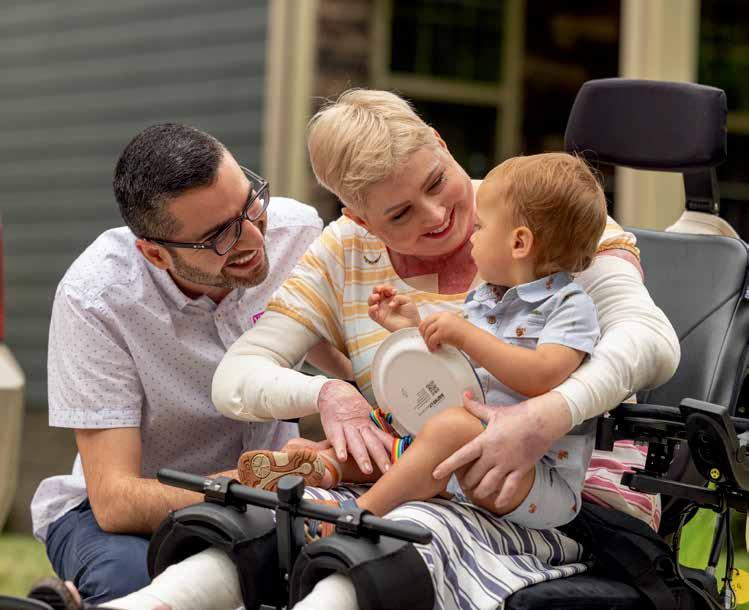
“For me, the number one thing that I had to learn, and am still learning, is patience — patience with myself and patience with everyone around me,” she said. “I am still working on self-acceptance and understanding that my new life is very different from life before. I am not able to do a lot of the things that I would do previously. I have to depend on a lot of people to help me, but our community is amazing.”
Xavier and her husband, André, are also committed to giving back and using their platform to share their story to inspire others. The pair recently published I Almost Lost Her, a memoir detailing their journey of tragedy and triumph.
“People from all over the world reached out to us and provided support, prayers, cards and messages,” André said. “It has been an incredible and humbling experience, and we understand that we now have a responsibility to share Charlie’s story and to encourage and inspire others who may have gone through or are going through similar experiences.”
But the most important thing for her right now?
“Just being a mom to my two boys.”
Charlie Xavier (center) savors a moment with her son and her husband, André, when coming home from the hospital.
MCV FOUNDATION 25
Photo: Lisa Watson
SCALING UP
VCU’s Medicines for All Institute is at the center of a growing regional hub that will address pharmaceutical supply and manufacturing challenges around the world.
By Eric Peters
For six years, a small but growing institute at VCU known as Medicines for All (M4 ALL) has been quietly dismantling complex global pharmaceutical, public health and even national security challenges. Using its own unique yet commonsense approach to chemistry and drug manufacturing, M4 ALL has seemed to punch above its weight class in every project it has taken on.
Often with the financial support of large organizations like the Bill & Melinda Gates Foundation, which have recognized significant potential in the institute, M4 ALL has used its approach to dramatically improve yields, reduce waste and curtail prices for widely prescribed HIV drugs; improve efficiencies and global access to the most prescribed COVID-19 medications; and produce on-site the newest and hardest-to-get cancer therapies to be used in clinical trials at VCU Massey Cancer Center.
Medicines for All projects have made significant impact and change, but many have been relatively smaller, targeted endeavors limited by the size and infrastructure of the institute. After an announcement earlier this year, however, M4 ALL’s scale and approach likely will never again be classified as quiet or small.
Sites in Richmond, Petersburg and Chesterfield will soon be working in concert to usher pharmaceutical production of essential medications from research and development to large-scale manufacturing.
MCV FOUNDATION 27
BUILDING A REGIONAL PHARMACEUTICAL ECOSYSTEM
The U.S. Department of Commerce’s Economic Development Administration announced in September that a coalition of public and private sector stakeholders in the Richmond-Petersburg region, including VCU and its M4 ALL institute, would receive nearly $53 million as part of the national Build Back Better Regional Challenge.
“The idea is we are going to create this ecosystem in Central Virginia for advanced pharmaceutical manufacturing so we can re-onshore drug production in the U.S. and have direct access without having to import vital medications,” said Frank Gupton, Ph.D., founder and CEO of M4ALL. “And we will do it in a cost-competitive and environmentally friendly way.”
The Richmond-Petersburg coalition — Alliance for Building Better Medicine — works to scale up the region’s advanced pharmaceutical manufacturing and research and development cluster to address the nation’s pressing need for quality, affordable essential medicines. Coalition members will leverage the Build Back Better Regional Challenge funding — which will be matched by $58 million from the state and local public and private organizations for a total investment of more than $110 million — for six component projects made up of a combination of infrastructure and programmatic projects.
Medicines for All is the cornerstone of the coalition, which in 2021 won Phase 1 of the Build Back Better Regional Challenge and began to plan in detail the six projects now funded with the support of Activation Capital, the cities of Petersburg and Richmond, Civica Inc., Community College Workforce Alliance, Greater Richmond Partnership, VCU College of Engineering, Virginia
Improving the Process
The Medicines for All Institute reevaluates the decades-old processes that are being used to produce global health drugs by substituting lower-cost materials, simplifying operations, reducing waste and increasing yields. These changes dramatically reduce selling prices and improve access and supply chains around the world.
Economic Development Partnership, Virginia’s Gateway Region, Virginia State University, Commonwealth Center for Advanced Manufacturing, GENEDGE, Brightpoint Community College and Reynolds Community College.
All of these partners are coalescing around M4 ALL’s unique, highly impactful approach so it can be scaled up dramatically to save and improve countless more lives locally and around the world.
THE M4ALL APPROACH
Founded in 2017 with funding from the Gates Foundation, M4ALL examines commercial drug manufacturing processes to find ways to substitute lower-cost raw materials, simplify operations and increase yields. It then transfers its findings to manufacturers and suppliers that can reduce consumer prices and establish production closer to patients, where it previously wasn’t economical to do so.
M4ALL’s early work included nevirapine, a widely prescribed treatment for HIV at the time that is on the World Health Organization List of Essential Medicines. Dr. Gupton’s team pinpointed inefficient chemical conditions and production processes related to the drug, then streamlined routes to the materials that come together to create its active pharmaceutical ingredient (API), ultimately reducing input materials, waste and cost.
Synthetic processes to develop new APIs, especially in times of great need such as a global pandemic, often evolve with limited regard for commercial viability and efficiency. These early processes help define the final commercial production processes because they are the fastest route to market.
When the drugs are in market but still being manufactured through their original inefficient processes, that is where
Substitute lower-cost raw materials Simplify operations Reduce solvent use and waste Commercial process Novel Chemistry 1 28 WINTER 2023
Dr. Gupton’s team makes an impact. “We look at drugs with a new set of eyes and some new chemistry tools, and we make them more cost-effectively and more accessible to people around the world,” he said.
In addition to lowering costs and access to drugs, the fresh perspective M4ALL is applying reduces the environmental impact of drug making. Through its original production processes, for example, nevirapine produced about 60 kilograms of waste per kilogram of final product, but Dr. Gupton’s team cut that waste to just 4 kilograms.
“One of the interesting things about the pharmaceutical industry is they’re using 19th-century technology,” Dr. Gupton said. “Active pharmaceutical ingredient manufacturing has been and still is practiced using batch manufacturing platforms.” This technology is like using massive beakers to manufacture drugs in single lots. But Dr. Gupton’s team is implementing continuous flow chemistry when and where it can, which is a process more akin to an assembly line.
“The pharmaceutical industry represents roughly 10% of the U.S. GDP,” said Dr. Gupton, who is a professor and chair of the Department of Chemical and Life Science Engineering at VCU’s College of Engineering and the Floyd D. Gottwald Jr., Chair in Pharmaceutical Engineering at VCU. “They are essentially the only ones not using an assembly line approach to manufacture their product.”
THE COMPONENTS OF A REGIONAL PHARMACEUTICAL ECOSYSTEM
The effort to scale up M4ALL’s approach is already attracting well-known organizations to the region that want to help, including Walmart, which is a major provider for pharmaceuticals nationwide, and U.S Pharmacopeia
Transforming global health drug development
Reducing dependence on offshore production
Increasing access to essential medicines in LMICs

Reduction in Retail Manufacturing Costs:
COVID-19 Drugs
Remdesivir: -4%
Molnupiravir: -92%
Nirmatrelvir: -58%
TB Drugs
Pretomanid: -85%
Sutezolid: -81%
Bedaquiline: -67%
Domestic Production: Developed and Transferred New and More Efficient Processes for Five Essential Drugs as a Subcontractor on a $400 million BARDA award
Projected Annual Savings: Approximately $85–$90 million across the three HIV regimens
Transfer to API Manufacturers 2 Track Price Reductions 3 Nevirapine Price Trends (2014–2016) Low Price High Price 2014 2014.5 2015 2015.5 2016 2016.5 $140 $130 $120 $ 110 $100 $ 90 $ 80 Transfer process to manufacturers MCV FOUNDATION 29
(USP), a nonprofit that protects patient safety and improves health around the world through establishing rigorous science and public quality standards. USP and many other organizations will co-locate with the regional alliance’s members.
The EDA Build Back Better funding will drive six projects, establishing the alliance as a global leader in improving access to medications and cementing the region as an international hub for pharmaceutical manufacturing, research and education.
Nearly $35 million will be invested to improve infrastructure in Petersburg’s Poor Creek service area, where some manufacturing facilities have been established and many more are expected.
“We have a seat of pharmaceutical manufacturing in Petersburg that existed roughly 30 years ago that dried up as offshoring of manufacturing became common,” said Joy Marie Polefrone, Ph.D., executive director of the Alliance for Building Better Medicine. “Companies went to other locations, but it has been reinvigorated with companies like Ampac Fine Chemicals, Phlow and Civica establishing their manufacturing sites there. In addition to manufacturing in Petersburg, we have technical capabilities within universities in chemistry and chemical engineering for pharmaceuticals, which can support both the research and educational needs of a growing industry cluster.”
In Richmond, some of those labs providing the technical capabilities Polefrone mentions will be updated, while construction on new pharmaceutical spaces will also begin
in city. For example, an innovation center with additional wet lab space in the Virginia Bio+Tech Park, located next to VCU’s MCV Campus, will help existing organizations in the region grow. In December, two groups — Phlow Corp. and U.S. Pharmacopeia — announced the opening of new laboratories at the biotech park.
A third location in the regional hub is Chesterfield, where the alliance will construct a center to accelerate manufacturing innovation and the commercialization of lab discoveries. This first-of-its-kind facility will spur collaboration, invention and investment by speeding bench discoveries to commercial scale.
Organizations such as Civica, an international nonprofit whose mission is to ensure that essential generic medications are accessible and affordable, will be major tenants in Chesterfield. “With our scale-up facility adjacent,” Dr. Gupton said, “these organizations can come in to help us scale up the M4ALL processes and demonstrate that they are commercially viable.”
Dr. Polefrone sees it all coming together to create the foundation for a complete and effective package that can seed additional innovations in advanced pharmaceutical manufacturing.
“We have a group that makes active pharmaceutical ingredients in AMPAC. That is one of the pieces of the equation,” she said in an interview with The Business Journals. “We have Civica, which does the work of formulating those drugs. Their primary customers are health systems. They are standing up their first
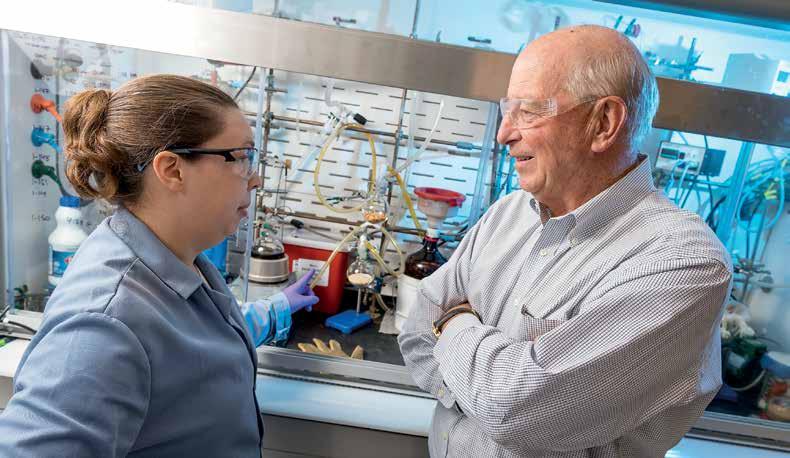
30 WINTER 2023
Cheryl Peck, Ph.D., a former postdoctoral research associate at the Medicines for All Institute, consults with Frank Gupton, Ph.D., at their lab in Richmond. Photo: Kevin Schindler
manufacturing site in Petersburg. And then we have Phlow, which is really responsible for building up that supply of essential medicines for the federal government.”
Dr. Gupton also sees Chesterfield as a training facility. “It will be open to people from around the world,” he said. “If we developed the process for manufacturing an AIDS drug with the Gates Foundation, we can now not only grow it to commercial scale but also bring people from Africa here to train so they can go back and make their own drugs.”
The alliance and Dr. Gupton’s team are also thinking about how to staff the coming regional pharmaceutical sector growth.
“Equally important to our work in directly producing low-cost processes and manufacturing techniques is the workforce-development component of our efforts,” Dr. Gupton said. “We’re thrilled to be collaborating on this area with Virginia State University and other educational institutions.”
Funding will be used to develop new and joint degree or research programs among VCU, VSU and industry partners. “By double majoring in chemistry and chemical engineering, these graduates will be uniquely qualified to meet the workforce requirements across the hub,” Dr. Gupton said.
Manufacturing technician training at Brightpoint Community College and laboratory technician training at Reynolds Community College, coordinated by the Community College Workforce Alliance, will also be developed.
Programmatically, funding from the EDA will help accomplish some of the alliance’s early output goals, such as developing a strategy to manufacture the starting materials of drugs. “We’re changing some of these manufacturing processes, so we no longer have to rely on foreign countries for the finished product, but if we’re still getting the starting materials from China, we’re in the same boat,” Dr. Gupton said.
“Our work at Medicines for All is the cornerstone of all of this activity,” Dr. Gupton said. “Because if you don’t have a low-cost process you won’t win the day with any of this stuff. The Gates Foundation had made this huge investment in our laboratories, the federal government had previously made an investment in Petersburg laboratories, so the good thing is we weren’t starting from scratch on this. We had a head start on this. This funding closed some really important gaps and made this regional hub vision a reality.”
Dr. Polefrone agrees.
“My hope is that in the next five years we have the ability to deliver on the vision that was seeded in the GO Virginia planning and implementation grants and further shaped in the federal grant, which is that we have the end-to-end system operational and working on the most meaningful challenges,” she said. “We have research and development.
That is happening at VCU and around the biotech community. We can then take what has been created in a research setting and build the processes and steps to take that from research to a full factory facility. And then we have manufacturing sites. We are building that end-toend capability within this region. It will be applied to the most essential areas, and that can be essential medicines or rare diseases or clinical trial drugs, or even generic manufacturing. If in five years we have that ability to go from research all the way through to scaling up the manufacturing, that would be a phenomenal accomplishment.”
If you are interested in helping the Medicines for All Institute improve access to critical medications in the U.S. and around the globe, contact Brian Campbell, senior campaign gift officer, at 919-812-1187 or becampbell@vcu.edu.
“We are going to create this ecosystem in Central Virginia for advanced pharmaceutical manufacturing so we can re-onshore drug production in the U.S. and have direct access without having to import vital medications. And we will do it in a costcompetitive and environmentally friendly way.”
MCV FOUNDATION 31
Frank Gupton, Ph.D., founder and CEO of M4ALL
Checking in with researchers on the latest developments
COVID-19 Smell Loss Research Yields Two Years of Insight
A team of researchers at VCU Health’s Smell and Taste Disorders Center, one of the few centers of its kind in the U.S., have published their findings from a nationwide self-assessment survey showing that while 7.5% of patients suffering from smell loss due to COVID-19 reported no recovery, most (92.5%) reported some recovery.
The study was published in the August issue of the American Journal of Otolaryngology. Richard M. Costanzo, Ph.D., a VCU Health physiologist, and Daniel H. Coelho, M.D., a VCU Health cochlear-implant surgeon, are two of the four authors. By analyzing data from different stages of the pandemic, the researchers were able to better characterize recovery estimations. While most people recover in the first three months, they found the recovery probability decreases with time.
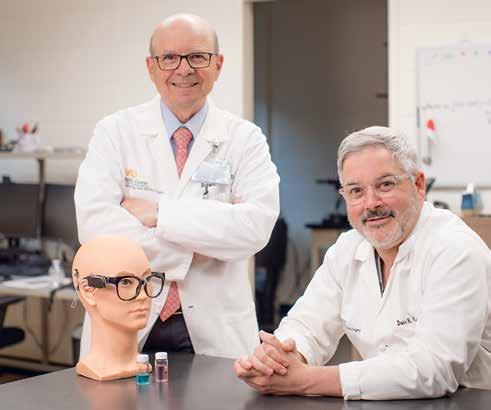
Their COVID-19 research is relevant to the olfactory implant project on which Drs. Costanzo and Coelho have been working for several years, which they hope will stimulate the parts of the brain responsible for smell in order to restore the sense. The implant project is progressing in collaboration with former students of Dr. Costanzo at Massachusetts General Hospital in Boston, neurosurgeon Mark Richardson and rhinologist Eric Holbrook. The Boston team is conducting clinical trials to study the brains of people who are undergoing epilepsy surgery with a goal to find where the best targets are in the brain to produce olfactory sensations.
“Unfortunately, there are no effective treatments for patients who have lost their sense of smell,” Dr. Coelho said. “We have made great progress toward helping patients who have lost their sense of smell, not only from COVID-19 but from other causes as well.”
Their work has received a lot of attention. This year, Dr. Costanzo received the Max Mozell Award for Outstanding Achievement in the Chemical Senses from the American Chemosensory Society. This was
special to Dr. Costanzo since its namesake, Maxwell M. Mozell, Ph.D., was his thesis advisor. Additionally, the researchers were featured in both Nature and IEEE Spectrum for their prototype device to restore smell sensation through electrical stimulation of the olfactory bulb. As the awareness in olfactory loss increases, so does the research.
“We are working toward a solution for people whom there is no solution right now,” Dr. Costanzo said. “We don’t want them to give up hope.”
32 WINTER 2023
Richard M. Costanzo, Ph.D., and Daniel H. Coelho, M.D., with a prototype of their device that could help restore a person’s sense of smell. Photo: DeAudrea “Sha” Aguado, VCU School of Medicine
Philips Institute Receives Grant to Advance HPV Research
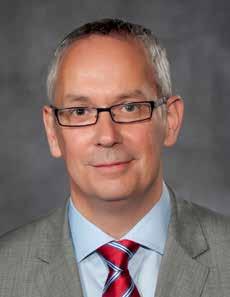
Researchers at the Philips Institute for Oral Health Research at the VCU School of Dentistry were awarded a $2.8 million, five-year R01 grant from the National Institute of Dental and Craniofacial Research to gain a better understanding of human papilloma virus replication and the implications for related cancers in the head and neck.
Now in the second year of funding, the grant is allowing VCU Health researchers to advance efforts to better understand HPV replication and determine the vulnerability of the virus to develop targeted therapeutics that can help prevent or treat HPV-related cancers.
NEXT magazine’s inaugural issue in 2017 covered Dr. Morgan’s work investigating which HPV-positive oropharyngeal patients should enter HPV-positive therapy de-escalation treatment and which should not. Because of this work it was determined that the HPV DNA in head and neck cancer, unlike in cervical cancer, remains mostly as a self-replicating molecule. In cervical cancer the viral genome most often integrates into that of the host and is replicated along with host DNA. This means that in head and neck cancer, the self-replicating viral DNA can potentially be targeted without damaging host DNA replication. Therefore, this would be targeted therapy for HPV positive head and neck cancers. At the same time,
Iain Morgan, Ph.D., chair of oral and craniofacial molecular biology, is director of the Philips Institute for Oral Health Research at the VCU School of Dentistry. He is a member of the Cancer Biology research program at VCU Massey Cancer Center and is collaborating on this research with Peitro Picheierri, Ph.D., a team leader at the Istituto Superiore di Sanita in Rome, Italy. Photo: VCU
HPV replication disrupts the host replication machinery.
Dr. Morgan’s team is aiming to find a vulnerability on the viral DNA and on the host DNA that can lead to therapy that will selectively kill only HPV-positive cells without causing harm to HPV-negative cells. This would effectively allow for less radiation and improved treatments and outcomes.
“In the School of Dentistry, we’re making a contribution to VCU Health’s priorities,” Dr. Morgan said, “and we’re making a contribution to VCU Massey Cancer Center and its mission.”
NEXT is published by the MCV Foundation to share the latest breakthroughs occurring at VCU Health and the positive impact these exciting innovations have on our patients.
CHIEF COMMUNICATIONS OFFICER
Eric Peters
EDITOR
Paul Brockwell Jr.
CONTRIBUTORS
Amber Logan, Danielle Pierce, Holly Prestidge, Zaynah Qutubuddin
GRAPHIC DESIGN
Big River Advertising
SCIENTIFIC ADVISORY PANEL
Joseph T. DiPiro, Pharm.D.
Susan G. Kornstein, M.D.
F. Gerard Moeller, M.D.
Patricia J. Sime, M.D.
The Medical College of Virginia Foundation was established in 1949 to inspire and steward philanthropic resources for our MCV Campus partners at VCU Health.
MCV Foundation manages more than $900 million in assets to ensure VCU Health remains at the forefront of excellence and innovation in patient care, research and education as one of the top academic health centers on the East Coast. Through more than 1,800 funds, the MCV Foundation provides scholarships, professorships, research and program funds to support the lifesaving work occurring at VCU Health every day. The MCV Foundation’s campus partners include: VCU College of Health Professions, VCU School of Dentistry, VCU School of Medicine, VCU School of Nursing, VCU School of Pharmacy, VCU Massey Cancer Center and VCU Medical Center.
To learn more, visit : www.mcvfoundation.org
Please address comments or subscription requests to: MCV Foundation
Attention: Communications Department 1228 East Broad Street Box 980234 Richmond, VA 23298 info@mcvfoundation.org
A PUBLICATION OF MCV FOUNDATION
NONPROFIT ORGANIZATION US POSTAGE PAID PERMIT NO. 1182 RICHMOND, VA
Box 980234 Richmond, VA 23298-0234



 By Holly Prestidge
By Holly Prestidge


 By Paul Brockwell Jr.
By Paul Brockwell Jr.











 By Paul Brockwell Jr. and Danielle Pierce
By Paul Brockwell Jr. and Danielle Pierce








